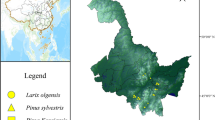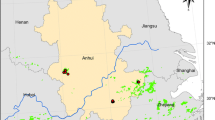Abstract
This study was carried out to determine the performance of percentile-based Weibull diameter distribution model for Pinus thunbergii stands thriving along the eastern coast of South Korea. The parameter recovery technique was used to estimate the three parameters of the Weibull model. The analysis demonstrated satisfactory results based on the following test statistics for the principal percentile models: fit index (FI) range from 0.501 (minimum diameter) to 0.932 (50th diameter percentiles) and root mean square error (RMSE) range from 0.112 (quadratic mean diameter) to 3.572 (minimum diameter). The developed model was further evaluated by determining the mean bias (Ē) in trees per ha (TPH) for each diameter class, and the results showed highest over-prediction in the 20 cm, and under-prediction in the 16 cm and 24 cm diameter classes. The goodness of fit tested by Kolmogorov-Smirnov (KS) test showed no significant differences (p>0.05) between the observed and predicted diameter distributions for almost all plots. Using site index and aboveground biomass (AGB) models developed for P. thunbergii in South Korea, a model to predict the AGB per ha for each diameter class and subsequently the total AGB of the stand was created. An application guide was also created, which will serve as a decision-support tool for forest managers in quantifying the future total AGB in P. thunbergii stands located in the eastern coast of South Korea and, subsequently, the quantification of potential carbon stocks aside from being a vital input in designing efficient management and protection strategies for these stands.
Similar content being viewed by others
References
Avery TE, Burkhart HE (1994) Forest measurement, 4th ed. McGraw-Hill, Inc., New York. p 408.
Bailey RL, Dell TR (1973) Quantifying diameter distribution with the Weibull-function. Forest Science 19(2): 97–104.
Bailey RL, Burgan TM, Jokela EJ (1989) Fertilized midrotationaged Slash pine plantations-stand structure and yield prediction models. Southern Journal of Applied Forestry 13(2): 76–80.
Bullock BP, Burkhart HE (2005) Juvenile diameter distributions of loblolly pine characterized by the twoparameter Weibull function. New Forests 29:233–244. DOI: 10.1007/s11056-005-5651-5
Cao QV (2004) Predicting parameters of a Weibull function for modeling diameter distribution. Forest Science 50(5): 682–685.
Cháidez JJN (2009) Allometric equations and biomass expansion factors for tropical dry forest trees of Eastern Sinaloa, Mexico. Tropical and Subtropical Agroecosystems 10: 45–52.
Chapman DG (1961) Statistical problems in dynamics of exploited fisheries populations. In: Neyman J (ed.), Proc. 4th Berkeley Symp. on Mathematical Statistics and Probability, Berkeley, CA, USA. Volume 4, p 153–168.
Choi KH, Kim YM, Jung PM (2013) Adverse effect of planting pine on coastal dunes, Korea. Journal of Coastal Research 65: 909–914. DOI: 10.2112/SI65-154.1
Coble DW, Lee YJ (2008) A new diameter distribution model for unmanaged Slash pine plantations in East Texas. Southern Journal of Applied Forestry 32(2): 89–94.
Corbera E, Schroeder H (2011) Governing and implementing REDD+. Environmental Science and Policy 14: 89–99. DOI: 10.1016/j.envsci.2010.11.002
Dai L, Jia J, Yu D, et al. (2013) Effects of climate change on biomass carbon sequestration in old-growth forest ecosystems on Changbai Mountain in Northeast China. Forest Ecology and Management 300: 106–116. DOI: 10.1016/j.foreco.2012.06.046
Da Silva JAA (1986) Dynamics of stand structure in fertilized Slash pine plantations. PhD thesis, University of Georgia, Athens, GA, USA. p 139.
Duan A, Zhang J, Zhang X, et al. (2013) Stand diameter distribution modelling and prediction based on Richards function. PLoS ONE 8(4): e62605. DOI: 10.1371/journal.pone.0062605
Farjon A, Filer D (2013) An ATLAS of the World’s Conifers: An Analysis of their Distribution, Biogeography, Diversity and Conservation Status. Koninklike Brill NV, Leiden, The Netherlands. p 512.
Gorgoso JJ, Rojo A, Camara-Obregon A, et al. (2012) A comparison of estimation methods for fitting Weibull, Johnson’s SB and beta functions to Pinus pinaster, Pinus radiata and Pinus sylvestris stands in northwest Spain. Forest Systems 21(3): 446–459. DOI: 10.5424/fs/2012213-02736
Jaworski A, Podlaski R (2012) Modelling irregular and multimodal tree diameter distributions by finite mixture models: an approach to stand structure characterisation. Journal of Forest Research 17(1): 79–88. DOI: 10.1007/s10310-011-0254-9
Kayes I, Deb JC, Das S (2012) Comparing normal, lognormal and Weibull distributions for fitting diameter data from Akashmoni plantations in the north-eastern region of Bangladesh. Southern Forests 74(3): 175–181. DOI: 10.2989/20702620.2012.717409
Kim KD (2005) Invasive plants on disturbed Korean sand dunes. Estuarine, Coastal and Shelf Science 62: 353–364. DOI: 10.1016/j.ecss.2004.09.023
Korea Forest Research Institute (2012) Volume, biomass and stand yield table. p 224.
Korea Forest Service (2013) Statistical yearbook of forestry. p 488.
Korea Meteorological Administration (2013) Available online: http://www.kma.go.kr/weather/climate/past_table.jsp (Accessed on 14 July 2014)
Lai J, Coomes DA, Du X, et al. (2013) A general combined model to describe tree-diameter distributions within subtropical and temperate forest communities. Oikos 122: 1636–1642. DOI: 10.1111/j.1600-0706.2013.00436.x
Lee BD, Won MS, Lee YH, et al. (2012) Crown fuel characteristics and carbon emission from Japanese red pine stands burned by crown fire in Mt. Palgong, South Korea. Journal of Mountain Science 9(5): 656–664. DOI: 10.1007/S11629-012-2397-3
Lee YJ, Coble DW (2006) A new diameter distribution model for unmanaged Loblolly pine plantations in east Texas. Southern Journal of Applied Forestry 30(1): 13–20.
Lumbres RIC, Lee YJ (2014) Percentile-based Weibull diameter distribution model for Pinus kesiya stands in Benguet province, Philippines. Southern Forests 76(2): 117–123. DOI: 10.2989/20702620.2014.918689
Main-Knorn M, Cohen WB, Kennedy RE, et al. (2013) Monitoring coniferous forest biomass change using a Landsat trajectory-based approach. Remote Sensing of Environment 139: 277–290. DOI: 10.1016/j.rse.2013.08.010
Maltamo M, Puumalainen J, Päivinen R (1995) Comparison of beta and Weibull functions for modelling basal area diameter distribution in stands of Pinus sylvestris and Picea abies. Scandinavian Journal of Forest Research 10: 284–295. DOI: 10.1080/02827589509382895
Nord-Larsen T, Cao QV (2006) A diameter distribution model for even-aged beech in Denmark. Forest Ecology and Management 231: 218–225.
Palahi M, Pukkala T, Blasco E, et al. (2007) Comparison of beta, Johnson’s SB, Weibull and truncated Weibull functions for modeling the diameter distribution of forest stands in Catalonia north-east of Spain. European Journal of Forest Research 126: 563–571. DOI: 10.1007/s10342-007-0177-3
Podlaski R, Roesch FA (2014) Modelling diameter distributions of two-cohort forest stands with various proportions of dominant species: a two-component mixture model approach. Mathematical Biosciences 249: 60–74. DOI: 10.1016/j.mbs.2014.01.007
Podlaski R, Zasada M (2008) Comparison of selected statistical distributions for modelling the diameter distributions in nearnatural Abies–Fagus forests in the Swietokrzyski National Park (Poland). European Journal of Forest Research 127: 455–463. DOI: 10.1007/s10342-008-0229-3
Poudel KP, Cao QV (2013) Evaluation of methods to predict Weibull parameters for characterizing diameter distributions. Forest Science 59(2): 243–252. DOI: 10.5849/forsci.12-001
Richards FJ (1959) A flexible growth function for empirical use. Journal of Experimental Botany 10: 290–301. DOI: 10.1093/jxb/10.2.290
Robinson A (2004) Preserving correlation while modeling diameter distributions. Canadian Journal of Forest Research 34: 221–232. DOI: 10.1139/x03-191
Sanquetta CR, Behling A, Corte APD, et al. (2014) A model based on environmental factors for diameter distribution in black wattle in Brazil. PLoS ONE 9(6): e100093. DOI: 10.1371/journal.pone.0100093
SAS Institute Inc (2004) SAS/STAT 9.1 User’s Guide. SAS Institute Inc., Cary. NC, USA.
Seo YO, Lee YJ, Lumbres RIC, et al. (2013) Influence of stand age class on biomass expansion factor and allometric equations for Pinus rigida plantations in South Korea. Scandinavian Journal of Forest Research 28(6): 566–573. DOI: 10.1080/02827581.2013.786126
Sheykholeslami A, Kia Pasha KH, Kia Lashaki A (2011) A study of tree distribution in diameter classes in natural forests of Iran (Case study: Liresasa forest). Annals of Biological Research 2(5): 283–290.
Siipilehto J, Mehtatalo L (2013) Parameter recovery vs. parameter prediction for the Weibull distribution validated for Scots pine stands in Finland. Silva Fennica 47(4): 1–22. DOI: 10.14214/sf.1057
Son JA, Hogetsu T, Moon YS (2014) The process of epithelial cell death in Pinus thunbergii caused by the pine wood nematode, Bursaphelenchus xylophilus. Nematology 16(6): 663–668. DOI: 10.1163/15685411-00002795
Son YM, Pyo JK, Kim SW, et al. (2012) Prediction of stand volume and carbon stock for Quercus variabilis using Weibull distribution model. Journal of Korean Forest Society 101(4): 599–605. (In Korean with English abstract).
Stankova TV, Zlatanov TM (2010) Modeling diameter distribution of Austrian black pine (Pinus nigra Arn.) plantations: a comparison of the Weibull frequency distribution function and percentile-based projection methods. European Journal of Forest Research 129: 1169–1179. DOI: 10.1007/s10342-010-0407-y
Tobita H, Hasegawa SF, Tian X, et al. (2010) Spatial distribution and biomass of root nodules in a naturally regenerated stand of Alnus hirsuta (Turcz.) var. sibirica. Symbiosis 50: 77–86. DOI: 10.1007/s13199-009-0032-z
Tsogt K, Lin C (2014) A flexible modeling of irregular diameter structure for the volume estimation of forest stands. Journal of Forest Research 19: 1–11. DOI: 10.1007/s10310-012-0380-z
Yang JE, Lee WY, Ok YS, et al. (2008) Soil nutrient bioavailability and nutrient content of pine trees (Pinus thunbergii) in areas impacted by acid deposition in Korea. Environmental Monitoring and Assessment 157(1-4): 43–50. DOI: 10.1007/s10661-008-0513-1
Zhao J, Kang F, Wang L, et al. (2014) Patterns of biomass and carbon distribution across a chronosequence of Chinese pine (Pinus tabulaeformis) forests. PLoS ONE 9(4): e94966. DOI: 10.1371/journal.pone.0094966
Zheng L, Zhou X (2010) Diameter distribution of trees in natural stands managed on polycyclic system. Forestry Studies in China 12(1): 21–25. DOI: 10.1007/s11632-010-0009-2
Author information
Authors and Affiliations
Corresponding author
Additional information
http://orcid.org/0000-0003-4162-5085
http://orcid.org/0000-0002-4277-3082
http://orcid.org/0000-0003-4221-6435
http://orcid.org/0000-0001-6839-258X
http://orcid.org/0000-0003-1967-1560
http://orcid.org/0000-0003-2278-6393
http://orcid.org/0000-0002-9319-1533
Electronic supplementary material
Rights and permissions
About this article
Cite this article
Abino, A.C., Kim, S.Y., Lumbres, R.I.C. et al. Performance of Weibull function as a diameter distribution model for Pinus thunbergii stands in the eastern coast of South Korea. J. Mt. Sci. 13, 822–830 (2016). https://doi.org/10.1007/s11629-014-3243-5
Received:
Revised:
Accepted:
Published:
Issue Date:
DOI: https://doi.org/10.1007/s11629-014-3243-5




